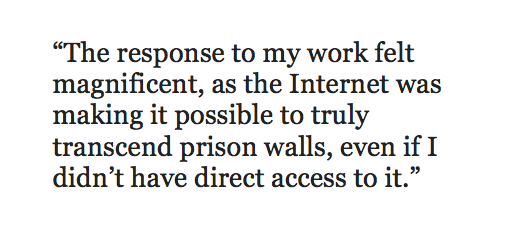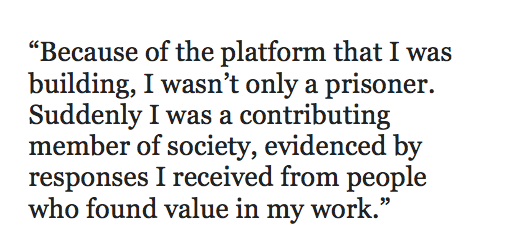By MICHAEL SANTOS
On August 11, 1987, DEA agents arrested me for leading a Continuing Criminal Enterprise, a serious charge frequently referred to as “The Kingpin Statute.” I was 23 years old and facing a sentence of life in prison. I faced a severe sentence of 45 years because of the leadership role I played in a scheme to distribute cocaine. My attorney convinced me that with the right amount of money I could beat the case, even though I knew that I was guilty.
It wasn’t until after the jury convicted me on all counts that I realized what a horrific disappointment my past decisions had made of me. During the period between my conviction and the day of sentencing, I resolved to make some changes. I wanted to reconcile with society, but I didn’t know what that might mean. I prayed for guidance. Those prayers led me to a philosophy book called A Treasury of Philosophy, an anthology that featured the work of many well-known philosophers.
 Only a mediocre student in high school, in jail I realized that I had to make better decisions. A Treasury of Philosophy introduced me to many thinkers, including Aristotle, Rousseau, and Kant. But it was the story of Socrates that really spoke to me. Socrates, too, was in jail, and yet when given the opportunity to leave, he declared that instead of running away from his problems, he would endure his sanction with dignity. That story inspired me to do the same—to serve my sentence with dignity.
Only a mediocre student in high school, in jail I realized that I had to make better decisions. A Treasury of Philosophy introduced me to many thinkers, including Aristotle, Rousseau, and Kant. But it was the story of Socrates that really spoke to me. Socrates, too, was in jail, and yet when given the opportunity to leave, he declared that instead of running away from his problems, he would endure his sanction with dignity. That story inspired me to do the same—to serve my sentence with dignity.
But what did that mean? How would I work toward reconciling with society? I didn’t know how to accomplish such a goal. I thought about law-abiding citizens and wondered what I could do to earn their forgiveness for the bad decisions I had made during a reckless transition between adolescence and adulthood.
Those thoughts led to a three-part plan that I came up while feeling the walls of my cell closing in on me:
1. I would work to educate myself,
2. I would work to contribute to society, and
3. I would work to build a support network that would have a vested interest in my success upon release.
Those three principles guided me through the 9,135 days that I served in prisons of every security level.
So I embarked on the first prong of the strategy. I earned a bachelor of arts in Human Resources Management from Mercer University, and an interdisciplinary master’s degree from Hofstra University, with focuses on cultural anthropology and political science.
For the second prong of the strategy, I started writing my own books to help others understand prisons: the people they hold, how they work, and strategies for growing through confinement.
And for the third prong, I worked every day to build a support network that would help me succeed upon release as a law-abiding, contributing citizen. This is what lead me to the Internet.
I embarked upon that strategy of building my support network long before the Internet existed. To meet new people, I created a document that I called “my portfolio.” It was a binder that included copies of my degrees and letters of recommendation that I asked my professors to write on my behalf. Whenever I read of someone who I thought my have an interest in my work, I reached out by sending a letter and a copy of my portfolio. For every 100 letters I wrote, I received one or two responses. 
Some of those responses were from distinguished scholars who wrote extensively about the prison system. People like Norval Morris, from The University of Chicago; John DiIulio, from Princeton; and Joan Petersilia, from Stanford. They became mentors to me, opening numerous opportunities that few would think possible for a man serving a lengthy prison term. It worked so well that I met the love of my life, Carole, while serving a quarter century in prison. We married in a prison visiting room and nurtured our marriage through my final decade of imprisonment.
With Carole in my life, I was able to take indirect advantage of the technological evolution happening outside, even though I was locked inside the federal prison system and prohibited from access to technology. I considered it essential that I use the Internet to build a presence so that I could tell stories of the men around me. Our nation confines more prisoners per capita than any other nation on earth. America’s commitment to mass incarceration comes at an enormous cost, depleting budgets for health care, education, and other social services. I understood that technology could help spread awareness of the system, and that awareness, I believed, could lead to reforms that would stop the perpetuating cycles of failure.
Using blank pages of paper, I drafted a design for a website that I wanted Carole to build. The purpose of the site was to help others understand prisons, the people they hold, and strategies for growing through confinement. I wanted to document my journey, to show others the values-based, goal-oriented approach I took to the adversity of my life. I wanted others to see that with deliberate action steps, an individual could triumph over his environment. The Internet would help me do this.
 Neither technology nor social media was Carole’s strong suit, but we were a team and she served as my liaison to the world. She took my handwritten notes and converted them into a digital format, then loaded those writings onto the website.
Neither technology nor social media was Carole’s strong suit, but we were a team and she served as my liaison to the world. She took my handwritten notes and converted them into a digital format, then loaded those writings onto the website.
The response to my work felt magnificent, as the Internet was making it possible to truly transcend prison walls, even if I didn’t have direct access to it. By documenting my journey, I could add value to others who wanted to learn more about America’s prison system. Professors like George Cole, from the University of Connecticut, and Sam Torres, from California State University of Long Beach began using my work to educate students who studied prison.
I wrote daily about the lives of people around me, and a true sense of meaning came when others expressed interest. Because of the platform that I was building, I wasn’t only a prisoner. Suddenly I was a contributing member of society, evidenced by responses I received from people who found value in my work. The Internet helped me show that although the context of my story came from inside of prison boundaries, the real message was one of the human spirit overcoming adversity and anyone could find value in that message.
Efforts that Carole and I made to live transparently, using the Internet to memorialize our journey, helped to broaden my support network and opened opportunities that I could leverage upon my release. They enabled me to walk out of prison with values, skills, and resources that would ease my transition into society as a law-abiding, contributing citizen.

On August 13, 2012, Carole picked me up from prison and drove me to a halfway house in San Francisco. I’ve been free for less than five months, but I’ve used that time to nurture the seeds that Carole and I sowed together. I’ve launched a new website to bring products and services to market. Then I’ve been writing daily to build a social media presence on Facebook, Twitter, LinkedIn, and Quora. That investment of time has introduced my work to millions, and resulted in a front-page profile in the San Francisco Chronicle.
The context of my story may be prison, but my message is decidedly human. We all face adversity of one kind or another. The Internet helped me get to a place of hope, perseverance, and deliberate action. It shows that regardless of what challenges an individual or business faces today, that individual can set a principled plan to overcome those challenges. The Internet was crucial to re-connecting me to society today.
I will continue to use the Internet to connect with society, to show others the steps I used to conquer a quarter century in prison. I’m convinced that others can use those same strategies to achieve more fulfillment in their own lives.
Please stay tuned to the Daily Dot to read more about my experiences with the Internet after 25 years in prison.
Michael Santos is the author of numerous books that describe various aspects of the federal prison system. He most recent book, Earning Freedom: Conquering a 45-year Prison Term, shares events from the day of his arrest, on August 11, 1987 through the day of his release, on August 13, 2012. He speaks on subjects related to overcoming struggle and pursuing strategies for optimal personal performance. Michael makes himself available to answer any questions about his prison experience, his return to society after a quarter century in prison, or anything else. Follow him @MichaelGSantos.
Photographs courtesy of MIchael Santos and Carole Atwater.


